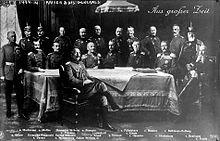- Operational Plan Three
-
Operational Plan Three (Operationsplan Drei in German) was the German Empire plan to invade the United States. The plan was ordered by Kaiser Wilhelm II at the end of the 19th century. The operation was shelved in 1907.
Contents
Background
Germany was a latecomer in the Empire Race, being that the country was unified in 1871, and the "race" began beforehand. Germany, like almost all European nations during the late nineteenth century, wanted the honor and security of having a large empire so they could increase their size, power, and wealth. Germany was intensely nationalistic, in fact the Germans have the term: Realpolitik, meaning practical or realistic politics that then implied the use of any means to achieve nationalistic aims, such as unification, empire-building and cultural prestige.[1][2]
It is alleged that the German General Staff was intensely jealous of the United States and its vast wealth. They despised their ever growing hold over the Pacific, which increased during the late nineteenth century. However, the only colony America had was the Philippines, which it acquired from the dwindling Spanish Empire in 1898 after their defeat in the Spanish-American War.[3][4][5]
The Plan
The invasion of the United States was considered vital by many within the reticent German General Staff. The plan was of great detail, and it included an attack on America's Eastern Seaboard with 60 ships and 100,000 men. They planned to start off by shelling Manhattan and capturing Boston.[6]
Kaiser Wilhelm II was more militaristic than his father, who died on the throne in 1888. Wilhelm II was a vehement critic of capitalism and democracy, particularly the kind that was practiced by the United States. He felt that capitalism was incredibly vulnerable; he believed that an attack on the international systems of trade, credit, and insurance could bring America to its knees.[5]
In 1903 Eberhard von Mantey, a war planner with the German Admiralty Staff, wrote in his diary that the "East Coast is the heart of the United States and this is where she is most vulnerable. New York will panic at the prospect of bombardment. By hitting her here we can force America to negotiate."[7]
However, various factors would contribute to the shelving of this operation. One factor was the buildup of the United States Navy; German military leaders realized that the German Imperial Navy was not powerful enough for such an armada. It is alleged that they switched their focus on European domination, instead of global (for the time being).[5][7] As a result of this decision, the American Theater (1914-1918) saw relatively little action during World War I.
See also
- World War I
- Causes of World War I
- Kaiser Wilhelm II
- German Empire
Notes
- ^ David Fromkin, Europe's Last Summer: Who started the Great War in 1914?, (Vintage Books, 2004) p.17-20
- ^ Michael J. Lyons, World War I: A Short History, (Prentice Hall, 2000) p.11-17
- ^ Mark Sullivan, Our Times: The Turn of the Century, (Scribners, 1926) p.544
- ^ Larry Schweikart & Michael Allen, A Patriot's History of the United States, (Sentinel, 2004) p.470-71
- ^ a b c German archive reveals Kaiser's plan to invade America
- ^ Hew Strachan, The First World War: Volume I: To Arms', (Oxford, 2003)
- ^ a b Jonathan Lewis, The First World War DVD, Disc One, Part Three: Global War, (Image Entertainment, 2005)
Categories:- Causes of World War I
- Military of the German Empire
- Military plans
- Military history of Germany
Wikimedia Foundation. 2010.

